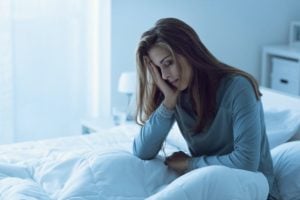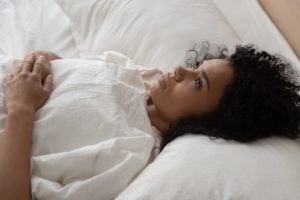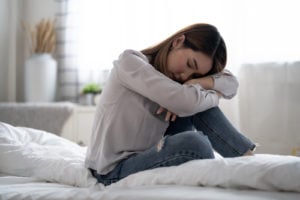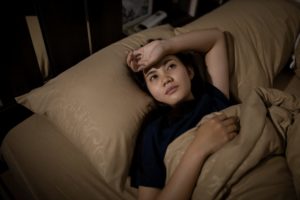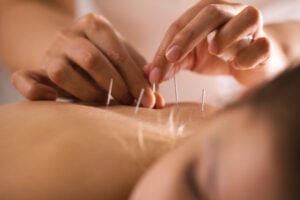Insomnia and Older Adults
Insomnia is a common sleep disorder characterized by a persistent difficulty to fall or remain asleep despite the opportunity to do so. People with insomnia also experience excessive daytime sleepiness and other cognitive impairments while they are awake that directly stem from sleep loss. People may have sleep-onset insomnia, which causes difficulty falling asleep, or sleep maintenance insomnia, which causes difficulty staying asleep. Some people with insomnia experience sleep onset and sleep maintenance issues.
According to current estimates, 10-30% of adults live with insomnia. People aged 60 and older are more susceptible to insomnia, and this can be attributed to a few different factors . Seniors are at higher risk of medical and psychiatric conditions that can lead to insomnia symptoms, as well as other sleep disorders such as sleep-disordered breathing or restless legs syndrome. Our internal circadian clocks and sleep-wake cycles can also change as we age, and these changes affect how long – and how well – we sleep. Additionally, certain medications used to alleviate symptoms of geriatric medical conditions can cause sleep disturbances.
Sleep and Aging
The quality of our sleep often deteriorates as we age. People tend to sleep less and are prone to more waking episodes after initially falling asleep. Sleep latency – the time it takes to fall asleep – may also increase. Some studies suggest that, beginning in middle age, the average person loses 27 minutes of sleep per night for each subsequent decade.
These decreases in sleep quality and duration are tied to the body’s internal timekeeping systems. The body cannot process circadian signals as efficiently, which in turn may cause older people to go to bed and wake up at earlier times.
Is Your Disrupted Sleep a Problem?
Answer three questions to understand if you should be concerned.
Our sleep architecture also changes as we age. A normal sleep cycle is divided into four stages. These include two stages of “light” non-rapid eye movement (NREM) sleep, one stage of “heavy” or “slow-wave” NREM sleep, and a final stage of rapid eye movement (REM) sleep before the cycle begins again. Polysomnographic studies have shown elderly people experience a lower percentage of both slow-wave NREM and REM sleep than their younger counterparts. This leaves them more susceptible to waking episodes during the night and also affects how refreshed and alert they feel in the morning.
Recognizing and Diagnosing Insomnia in Seniors
Insomnia and age often go hand in hand. While many seniors experience sleep problems because of natural changes to their circadian rhythm and sleep-wake cycle, a diagnosis for insomnia must meet certain criteria. According to the International Classification of Sleep Disorders (ICDS), a person with insomnia must report at least one of the following symptoms despite having enough time allotted for sleep and a relatively comfortable sleep area:
- Difficulty falling or staying asleep
- Repeated instances of waking up earlier than desired
- Feelings of resistance about going to bed at a reasonable time
- Difficulty sleeping without intervention from a caregiver
Insomnia must also include daytime impairments. These may include excessive daytime sleepiness, feelings of fatigue and malaise, mood disturbances and irritability, and trouble concentrating and paying attention. People with insomnia are at higher risk of accidents, and many struggle in social and family situations.
If these symptoms occur at least three times per week and persist for at least three months, then doctors may diagnose the patient with chronic insomnia. Until then, the condition is considered short-term insomnia .
Determining the root causes of insomnia in older adults is key to a successful diagnosis. Primary insomnia refers to insomnia symptoms that occur independently, while secondary insomnia occurs due to an underlying medical or psychiatric condition that causes sleep loss. Insomnia symptoms are the same regardless of whether the condition is considered primary or secondary. However, treating secondary insomnia typically requires patients to first address the primary condition that causes their sleep problems.

Treatment for Insomnia in Older Adults
For the management of chronic insomnia in seniors, the first step often focuses on sleep education and improved sleep hygiene. A doctor will consult with the patient about how to create and maintain a bedroom environment that is conducive to healthy sleep. The optimal bedroom should be dark and quiet, with a temperature lower than 75 degrees Fahrenheit (23.9 degrees Celsius). The bed should only be used for sleeping rather than other activities like working and playing video games. An air conditioner may be helpful during hotter times of the year. Doctors will also promote regular exercise and balanced meals, and discourage stimulants like caffeine and tobacco.
Other non-pharmacological treatments can help alleviate insomnia symptoms for seniors without prescription medication. These include:
- Stimulus control: This technique is rooted in the idea that patients should only go to bed when they are tired, and that lying awake can be detrimental to a good night’s rest. If the person lies awake in bed for 20 minutes without nodding off, they should get up and busy themselves in another room until they feel tired again. Furthermore, they should avoid napping during the day and commit to waking up at the same time each morning.
- Sleep restriction: Many insomnia patients are instructed to keep a sleep diary that records time asleep and awake, how long it takes to fall asleep each night, and other important patterns. Based on sleep diary notes, a doctor may tell the patient to restrict their time in bed each night until their sleep efficiency improves. Sleep efficiency is defined as the ratio between time asleep vs. time awake in bed each night. Once a person is able to sleep for at least 90% of the time they spend in bed, they can begin going to sleep earlier.
- Cognitive behavioral therapy: Cognitive behavioral therapy for insomnia helps seniors pinpoint negative attitudes and incorrect beliefs they have about sleep, and then replace them with a more informed and positive mindset.
- Bright light therapy: For seniors who go to bed and wake up relatively early, timed exposure to bright lights in the evening can help them stay awake a bit longer and fall asleep at a later time.
If these non-pharmacological interventions are not effective, then the doctor may consider sleep medications. Choosing appropriate insomnia medication for elderly patients requires a lot of care and consideration. Some medications, such as benzodiazepines (BZDs) and non-benzodiazepines (Z-drugs), produce hypnotic effects and can increase the risk of falling for older people. These drugs also carry a high tolerance, dependence, and withdrawal risk, and doctors should take their patient’s other prescriptions into account in order to prevent negative drug interactions.
Other insomnia medications carry lower risks, but they should still be prescribed with caution. Some medications promote sleepiness by interacting with natural hormones in the body. These include ramelteon, which acts as an agonist for receptors of melatonin, a hormone produced in the pineal gland that induces feelings of sleepiness after the sun goes down; and suvorexant, which suppresses orexins, neuropeptides that causes feelings of arousal and wakefulness. Over-the-counter antihistamines may also be prescribed.
You should always speak with a doctor before attempting any pharmacological or non-pharmacological insomnia treatments.
Other Common Sleep Disorders for Seniors
In addition to insomnia, studies have shown seniors are at higher risk of other sleep disorders. Many older patients experience insomnia along with other sleep disorders, which complicate treatment plans. Sleep disorders with a high prevalence rate among elderly populations include the following:
Circadian Rhythm Sleep Disorders
When a person’s circadian rhythm is not aligned with their external environment, they may experience a circadian rhythm sleep disorder. Older people are at higher risk of these disorders because the internal mechanisms that regulate circadian rhythm deteriorate with age.
Advanced sleep-wake phase disorder is particularly common in older populations. People with this order routinely feel tired in the early evening, typically between 7pm and 9pm, and will naturally wake up between 3am and 5am. Even if they go to bed later than usual, they often wake up relatively early due to their sleep-wake cycle. Timed light exposures in the evening can be used to treat these disorders for some elderly patients. A regimented sleep schedule can also be effective.
Another example is irregular sleep-wake rhythm disorder, which is predominantly found in adults with neurological and neurodegenerative conditions such as Parkinson’s disease and Alzheimer’s disease. This disorder is characterized by fragmented sleep patterns that do not follow a normal 24-hour day-night cycle.
While melatonin supplements can be used to treat circadian rhythm sleep disorders in younger people, physicians should carefully consider whether to prescribe this type of medication to senior patients. Melatonin supplements are not regulated by the U.S. Food and Drug Administration, and long-term efficacy and safety of these supplements are considered questionable.
Sleep-Related Breathing Disorders
Sleep-related breathing disorders, which include obstructive sleep apnea and central sleep apnea, are highly prevalent in older populations. These disorders are particularly common with elderly nursing home patients with dementia. Obesity, alcohol consumption, and smoking can also contribute to these disorders over time.
Sleep-related breathing disorders often cause seniors to snore heavily, which can lead to nighttime arousals and produce feelings of excessive daytime sleepiness. The disorders are also considered predictors for other medical conditions, such as congestive heart failure, myocardial infarction, and stroke.
Many seniors with sleep apnea are treated with continuous positive air pressure (CPAP) therapy, during which patients receive pressurized air through a breathing mask while they sleep. Those who comply with CPAP treatment often snore less and experience fewer apnea episodes during the night.
Periodic Limb Movements and Restless Legs Syndrome
Periodic limb movements are involuntary, repetitive movements of the arms and legs during sleep that occur more than 15 times per hour of sleep. Restless legs syndrome, a neurologic disorder, is characterized by the overwhelming urge to move one’s legs while the body is at rest. Both of these conditions can cause nighttime arousals that lead to waking episodes and tiredness the following day. Studies have shown the prevalence rate for these conditions almost doubles with age.
Many younger people with periodic limb movements or restless legs syndrome require medication to manage their condition. Interventions for seniors can be a bit trickier, especially if they currently take other drugs or have pre-existing conditions.
REM Sleep Behavior Disorder
People generally dream the most during REM sleep. Unlike most adults, those who have REM sleep behavior disorder (RBD) will physically act out on their dreams. This can entail violent movements that put the sleeper and their partner at a higher risk of bodily harm.
RBD has shown to be unusually common in elderly men. There is also a link between this disorder and degenerative neurologic conditions such as Parkinson’s disease and Lewy body dementia.
Since BZD medications are often prescribed for RBD, treating this disorder can be difficult for elderly patients. However, people with RBD can take precautions by optimizing the safety of their sleep area. Measures may include locking windows, placing the mattress on the floor, and removing objects from the bedroom that can cause injuries.
How Much Sleep Do Seniors Need?
The average senior needs at least seven hours of sleep each night in order to feel well-rested and alert the next day. Sleep disorders like insomnia can greatly interfere with your sleep schedule. If you experience sleep difficulties, try one of the following to ensure you get enough rest and feel refreshed in the morning:
- Impose strict bedtimes and waking times, and stick to them – even on the weekends or when you’re traveling.
- Avoid napping close to bedtime. If you need a few minutes of shut-eye, try to isolate your naps to the morning or early afternoon.
- Establish a routine that will help you wind down each night. Reading or listening to calming music can be effective.
- Do not use electronic devices such as televisions, cell phones, or computers in your bedroom. These devices emit a blue light that can make it harder to fall asleep.
- Maintain a balanced, comfortable temperature and low light levels in your bedroom.
- Exercise during the day but avoid working out within three hours of your bedtime.
- Do not consume caffeine in the late afternoon or evening.
- Do not drink alcohol as a sleep aid. While alcohol has sedative properties, it can actually cause sleep disturbances.
If you still experience problems with sleep onset or duration despite taking these measures, then you may have a sleep disorder. Consult with your physician about diagnosing the problem and treating it in accordance with your medical history.

Still have questions? Ask our community!
Join our Sleep Care Community — a trusted hub of sleep health professionals, product specialists, and people just like you. Whether you need expert sleep advice for your insomnia or you’re searching for the perfect mattress, we’ve got you covered. Get personalized guidance from the experts who know sleep best.
References
6 Sources
-
American Academy of Sleep Medicine. (2014). The International Classification of Sleep Disorders – Third Edition (ICSD-3). Darien, IL.
https://aasm.org/ -
Bhaskar, S., Hemavathy, D., & Prasad, S. (2016). Prevalence of chronic insomnia in adult patients and its correlation with medical comorbidities. Journal of Family Medicine and Primary Care, 5(4), 780–784., Retrieved from
https://pubmed.ncbi.nlm.nih.gov/28348990/ -
Stepnowsky, C., & Ancoli-Israel, S. (2009). Sleep and Its Disorders in Seniors. Sleep Medicine Clinics, 32(2), 281–293., Retrieved from
https://www.ncbi.nlm.nih.gov/pmc/articles/PMC2516307/ -
Suzuki, K., Miyamoto, M., & Hirata, K. (2017). Sleep disorders in the elderly: Diagnosis and management. Journal of General and Family Medicine, 18(2), 61–71., Retrieved from
https://www.ncbi.nlm.nih.gov/pmc/articles/PMC5689397/ -
McCall, W. V. (2004). Sleep in the Elderly: Burden, Diagnosis, and Treatment. The Primary Care Companion to the Journal of Clinical Psychiatry, 6(1), 9–20., Retrieved from
https://www.ncbi.nlm.nih.gov/pmc/articles/PMC427621/ -
Consensus Conference Panel, Watson, N. F., Badr, M. S., Belenky, G., Bliwise, D. L., Buxton, O. M., Buysse, D., Dinges, D. F., Gangwisch, J., Grandner, M. A., Kushida, C., Malhotra, R. K., Martin, J. L., Patel, S. R., Quan, S. F., Tasali, E., Non-Participating Observers, Twery, M., Croft, J. B., Maher, E., … Heald, J. L. (2015). Recommended amount of sleep for a healthy adult: A joint consensus statement of the American Academy of Sleep Medicine and Sleep Research Society. Journal of Clinical Sleep Medicine, 11(6), 591–592.
https://pubmed.ncbi.nlm.nih.gov/25979105/





